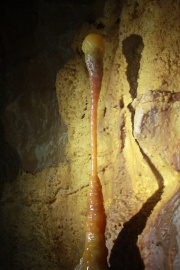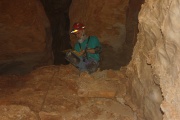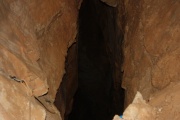Sling-shot Passage
From LagWiki
| Sling-shot Passage | |
|---|---|
| Location | SE New Mexico |
| Author | William Tucker |
| Date | May 6, 2017 |
In May, I got the opportunity to survey a virgin passage known as Sling-shot. Let me give you a little history as to how it got its name.
Contents |
2014
Way back in 2014, on a trip with Jason Walz, Mark Bulman, Derek Smith and myself, we used a sling-shot to catapult a lead weight on a string up over a chock stone in order to access what looked like a promising high lead.
That attempt turned into a drawn-out effort. I had no idea how hard it was going to be.
It took several tries; but, we did manage to get the string up over the chock stone; but, the weight got caught in some rocks higher up and we were unable to pull it down. Our original idea was to use the string to pull up a rope so that we could access this high lead. Now, it looked like we might need a new idea.
After many frustrating attempts to free the string, we finally gave up and cut it off at the floor. This left it hanging with the hope that we would be able to use it. We had no idea how at the time.
On the next trip, and after considerable thought and experiments at home, I came up with an idea. Jennifer Foote, Mark Bulman, Derek Smith and I were on the trip. I used a bundle of plastic tubes, each about 1 foot long. I inserted the string into each tube one at a time and pushed them upward. Each pushed on the other. On the top tube was a pulley and another string with a slip knot and weight. By stacking the tubes on top of each other around the stuck string, I successfully got the pulley into position on the other side of the chock stone high in the ceiling.
Then, I released the slip knot and lowered the new weighted string to the floor. From there, we tied on a dynamic rope and pulled it up, over the chock stone and through the pulley. It worked.
The next step took a little courage. Derek and I had been rehearsing at home for this move. We anchored Derek to the floor and had him belay me while I ascended the opposite side of the rope. I climbed up into the rocks to retrieve the stuck string and weight. Then, I climbed horizontally, also known as chimneying, about 20 feet through the fissure that the chock stone was stuck in to access the ledge at the target lead. I was attached to the rope with Derek belaying the move. It worked.
From there, we pulled up a static rope and I anchored the static rope up in the lead and Jennifer started to ascend.
While the rope was well anchored, the rocks on the end of the ledge were loose and some of them started falling on Jennifer. We quickly determined that the situation was unsafe and that we needed a better plan.
I descended the static rope while the others pulled on the dynamic rope attached to me. This was in order to pull me out at an angle away from any falling rocks. It was awkward; but, it basically worked.
That is how we left things in 2014: a dynamic rope up over the chock stone; and an unsafe static rope anchored up in the lead.
2016
Sometime in 2016, a team entered the cave and attached the static rope to the rock with bolts at the top. This would draw it away from the loose rocks and make it safer to ascend.
2017
In 2017, I got an opportunity to try again. Brian Alger, John Lyles, Janice Tucker and I were finally going to enter the Sling-shot Passage.
On May 6, 2017, we left camp at 8:00 AM. I guess we were anxious as this is earlier than what is usual. We were loaded down with gear. In addition to all of our survey equipment, and the necessary rope, we had an extra rope and rope pad. On a previous trip, some of the cavers noticed that one of the fixed ropes had a bad spot in it. One of our tasks was to replace that damaged rope.
We had no problems finding and rigging the rope in the cave. We did encounter a small rattlesnake on the hike to the cave; but it was quickly avoided. We all descended into the cave and proceeded across the traverse. The traverse crosses a pit which leads to a lower level. Crossing it put us at the top of the static rope that we planned to replace.
Because of the reports of a bad spot, I asked if anyone had any hesitation about descending the old rope. I gave the options of waiting until it had been replaced; or, of using a top rope to be sure. John had been on the trip that detected the bad spot and he said that it was not that bad. Besides, the rope had been turned, putting the bad spot closer to the floor. He had no qualms about rappelling it one more time and neither did any of the others. By rappelling, they could leave me to replace the rope while they started to resketch and reshoot some of the stations below. The data for these stations were known to have been rounded to the half foot. Our survey standards are 1/10 foot, so we needed to redo these.
Everyone had no problem descending the rope. Though the bad spot was noted, it did not cause any of them to stop their rappel.
After arriving at the bottom, they began to reshoot and resketch C5-C12. I used that time to replace the rope and pad and to pull up the old rope so that we could remove it from the cave. When I examined the old rope, it was clear that the bad spot was a problem. While the kern (the core) was still intact, the mantle (the sheath) was almost completely cut all the way around. This did not make the rope unsafe for a few rappels; but, it did make it in need of replacement.
I descended the new rope and joined the team to finish the resurvey task.
After we were done with that task, which was about noon, we moved to the based of the Sling-shot Passage.
I assigned tasks. Brian was to sketch. John was to do foresights. I was to do inventory. Janice got the enviable task of being lead which meant that she got to see everything first. We had prearranged to start a new survey letter so station K1 would be the first one set.
Janice proceeded up the rope and set a station on the edge so that we could tie the new passage back into the rest of the cave. After that was done, and a few more stations were set and surveyed, I followed Brian up the rope.
The passage was comfortably tall and wide. There was no stooping, crawling, or turning to fit through a narrow. This made it very nice to survey.
The first part of the passage was punky, sandy, rock with a breakdown floor. This quickly turned to more substantial limestone with breakdown in the floor. The entire passage floor was breakdown. It was covered with flowstone in places; and, it had enticing openings that we each took turns peering into to see if it went and was large enough to enter. While some holes in the floor looked like they might go, none were found to be big enough to enter.
Near station K5, the flowstone became substantial and we switched to aqua sox to avoid tracking across it.
At the back, at stations K7-8, we noticed what turned out to be a solution dome. It looked like it might be a lead; so, we took a moment to examine up into it to see if anything went. It did not; but, it was richly decorated with helictites, straws and stalactites.
We used stations K9 and K10 to survey behind a large rock flake which was well covered in popcorn and tiny helictites.
When I first saw this lead back in 2014, I had every hope but no evidence that it would go and go big. It ended up being about 250 feet in one direction, due south. It did not do what my wildest dreams imagined; but, it was a good lead.
We finished up the sketches and inventory notes at about 7:00 PM. This was early enough that John convinced us to go check out a blowing hole that he had found on an earlier trip.
We went back down the rope; but, not before I began to ponder how to get to the other side. While the Sling-shot Passage trends almost due south, it is obvious that it also continues to the north on the other side of the chock stone and the pit I once crossed. I need to figure out how to safely cross that opening, again.
We continued deeper into the cave to John's blowing hole. The hole is near the deepest known part of the cave. It does not seem to blow continuously. It seems to breath. It will blow for a few minutes and then stop or slow. After a few minutes, it will start, again. At no time did we observe it inhaling, though. Very curious.
John had brought with him a small video camera and a collapsible pole. With that, he passed the camera deep into the hole to see what he could see. He did observe a void; but, it was well over 10 feet inside the hole before it may open up somewhat. We do not know how much void there may be on the other side of the small blowing hole.
We discussed the possibility of starting a new survey project after filming the blowing hole. It was well after 8:00 PM and we thought it too late to begin something new. Besides, we still had several ropes to coil and a long way to go to get back to camp; so, we started toward the surface.
The last person reached the surface (me) at 11 PM. I found my pack to be quite heavy as I was carrying the dynamic rope which was soaked with water. The weight of the pack and the long day made my ascent a real struggle.
We arrived back at camp at about midnight to absolutely beautiful weather. After enjoying a much needed rest, we said our goodbyes and headed home the next morning.
So, I finally got into Sling-shot and it proved to be a good find.
Total travel time from camp to camp was 16 hours. Time in the cave was about 13 1/2 hours. It was a great trip and I can't wait to do it again. Going north at Sling-shot is calling to me.










